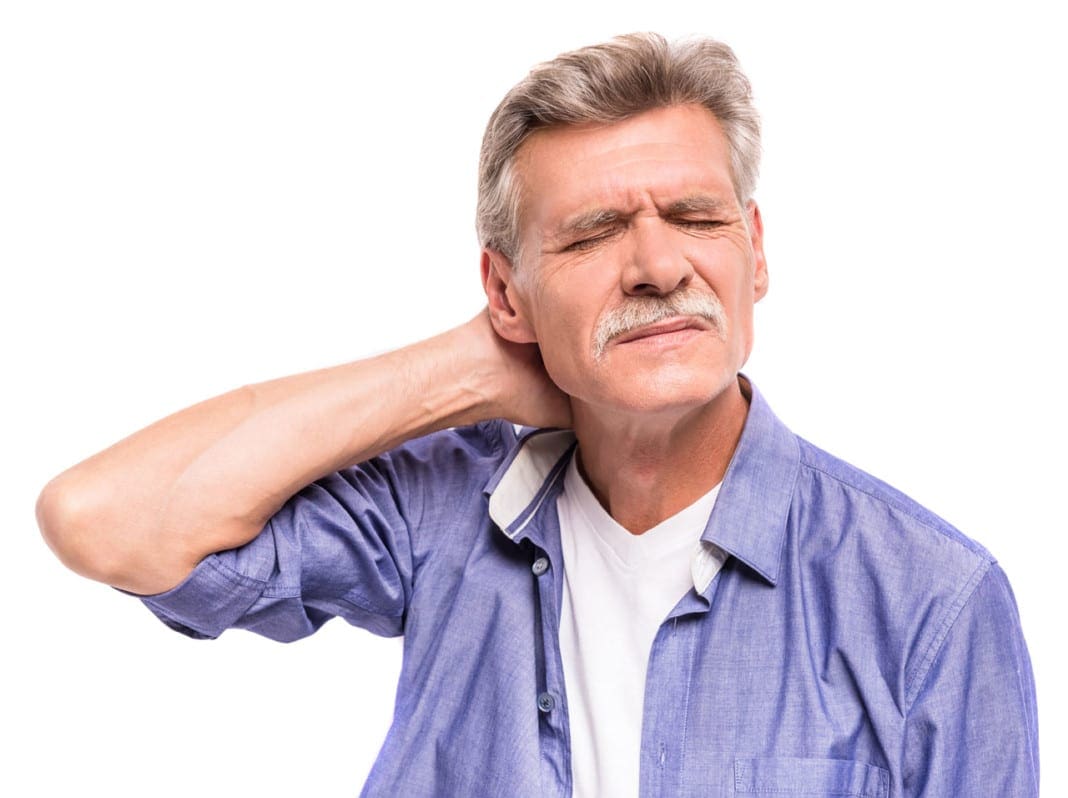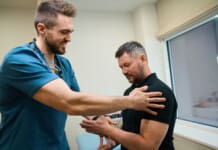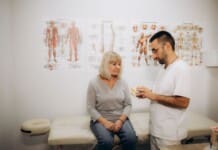When neck pain and becoming dizzy present it is called cervical vertigo or cervicogenic dizziness. It can present from different causes. It could be a recent or previous automobile accident, or from slouching too much while looking down at the phone, or it could be an arthritic condition acting up. Whatever the reason/s the spinning, neck pain, and headaches, need to stop. Cervical vertigo, also known as cervicogenic dizziness, is a feeling of disorientation or unsteadiness caused by a neck injury or health condition that affects the neck region of the spine.
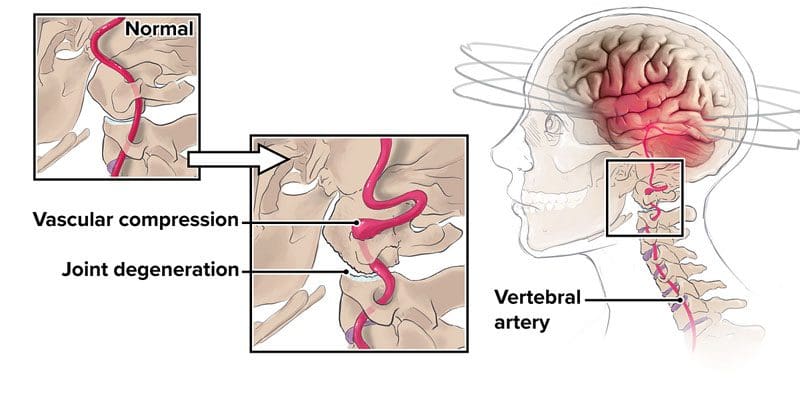
There is almost always neck pain when the dizziness starts up. The range of motion is affected and can present with a headache. A cervical vertigo episode can go on for hours, and the condition can last for years. Diagnosing cervical vertigo can be a challenge because some of the symptoms are similar or overlap with other medical issues. This can be inner ear infections/issues to stroke and traumatic brain injury/s like a concussion. Fortunately, once there is a correct diagnosis many of the treatment therapies can be done at home. If there is a cause coming from the neck then it can usually be treated without surgery.
Table of Contents
How Balance Works
Keeping the body upright and moving takes a great deal of coordination. Balance involves the:
- Eyes
- Muscles
- Joints
- And the nervous system working together with the inner ear organs called the vestibular system.
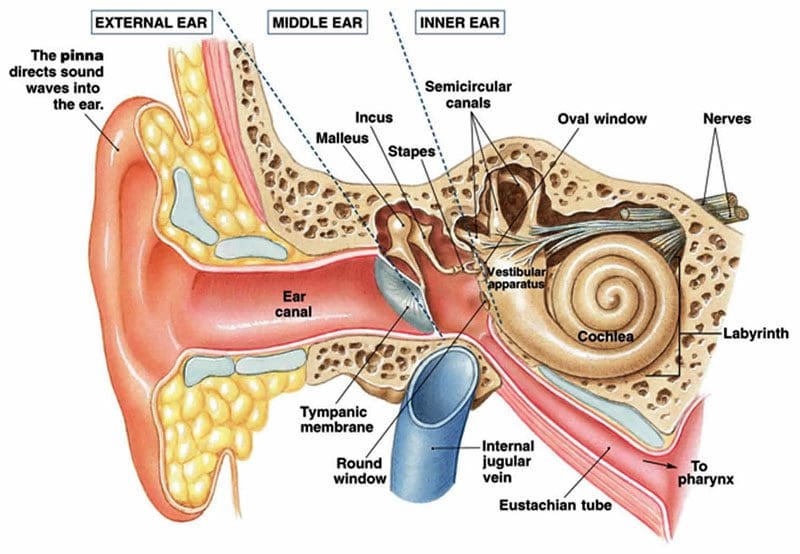
When everything is in sync, maintaining equilibrium is as natural as breathing. If one area gets damaged or becomes disrupted, maintaining vertical balance can be a challenge. The exact reason for cervical vertigo is still unknown, but many experts believe it involves a communication problem between the vestibular system and body awareness. Proprioception is the awareness of an individual’s body’s position and motions. It is how an individual knows where their limbs and joints are, and how they move through space. This awareness involves:
- Sensors in the skin
- Muscles
- Joints that send signals to the nervous system
There is a theory that cervical vertigo happens when an injury or health condition interferes with the receptors in the neck, which throws off proprioception. This affects the signals being transmitted to the brain and vestibular system. The result is vertigo.

Diagnosing Cervical Vertigo
There is no official test to diagnose cervical vertigo. Instead, a doctor needs to rule out other possible causes of symptoms and confirm the issue is neck-related. This is known as exclusion diagnosis. Other conditions that have similar symptoms and should be considered include:
- Concussion or mild traumatic brain injury
- Benign paroxysmal positional vertigo – BPPV is a vestibular system issue that causes a spinning feeling when moving the head a certain way
- Meniere’s disease
- Fluid on the brain
- Brain tumor
- Multiple sclerosis
- Stroke
Neck pain can be a clue that the problem could be cervical vertigo. When an individual has pain, it can be easier to diagnose because it is a kind of reference. When neck pain is not present, healthcare professionals look to the ear or brain.
Spine Conditions That Can Cause A Feeling of Being Dizzy
Sometimes, it can be caused by physical trauma, while other times, it is a result of a health condition that affects the spine. The most common causes include:
Age
Getting older is a potential risk factor from all the wear and tear of regular living. Age can affect neck strength, mobility and increases the chances of developing various health issues.
Whiplash
If the head and neck snap forward and backward at high speed, the result is often whiplash. It is a neck spasm after a high-velocity injury, most commonly an automobile accident.
Cervical spondylosis
This is also known as arthritis of the neck. Cervical spondylosis involves the breakdown of the spine’s discs and joints over time. The discs are the body’s shock absorbers. If they begin to lose water content this starts the degenerative inflammatory process. During this process, bone spurs can begin to develop. This can cause compression of the nerves, blood vessels, and the spinal cord, which can lead to vertigo.
Herniated disc
When the center of a spinal disc bulges out/herniates, it can press on the spinal cord, compressing the spinal cord or the nerves.
Poor posture
Slouching when sitting or looking down to read the phone can compress the vertebrae at the top of the spine.
Atherosclerosis
This is the hardening of artery walls and can restrict blood flow to areas that affect balance.
Neck surgery
This can cause vertigo if the surgery damaged the area, nearby blood vessels, or nerves.
Bow Hunter’s Syndrome
Also known as rotational vertebral artery occlusion. It is the compression of a blood vessel in the neck called the vertebral artery, although it is rare.
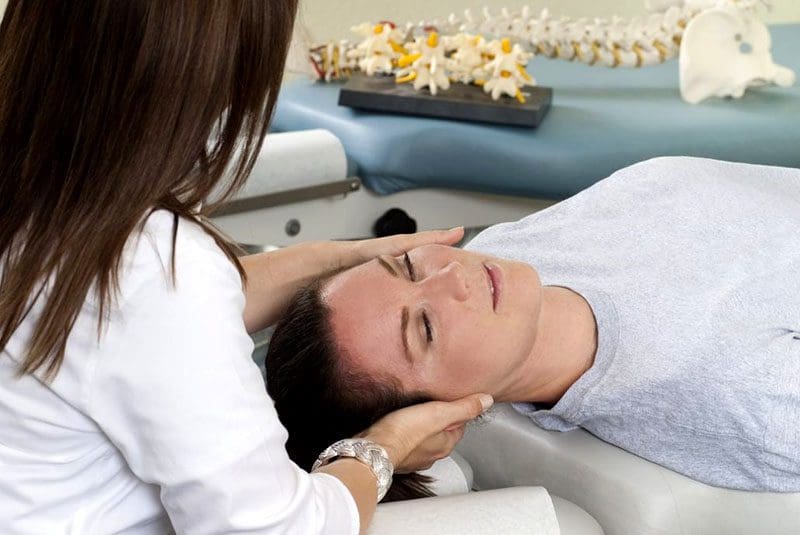
Treatment Options
Cervical vertigo can be managed without surgery. A healthcare provider can begin the process of diagnosing and start treating any underlying health problems to relieve symptoms. Muscle relaxers and over-the-counter analgesics like ibuprofen or acetaminophen can help with pain, and medications like meclizine can help with dizziness.
Aerobic exercise
Physical activities like walking, running, biking or swimming can reduce inflammation and pain. However, for aerobic exercise to be effective, the heart rate has to hit the aerobic zone for at least 15 to 30 minutes per session, at least 3 to 5 times per week.
Strength and balance training
Exercise can ease symptoms. Yoga, Pilates, and tai chi incorporate mindfulness and breathing techniques that are proven to help with pain relief.
Physical therapy
Physical therapy is recommended for building strength, improving posture, and neck mobility. Manual therapy works the muscles and joints and has been found to be helpful.
Massage
Therapeutic massage can be beneficial for cervical vertigo as it eases tension on the neck and allows better circulation in the arteries.
Acupuncture
Acupuncture has been shown to be beneficial for neck pain, and for the treatment of vertigo.
Chiropractic
Gentle chiropractic mobilization can help by correcting any injuries or misalignments.
Where to Go
Check with a healthcare provider first to check which is the right treatment to pursue. Conduct plenty of research and ask questions. Above all, don’t let symptoms go unaddressed.
Body Composition
Probiotics and Prebiotics
A probiotic is referred to as good bacteria that keeps viruses and bad bacteria in check. The health benefits range from:
- Boosting immune system function
- Reducing cholesterol levels
- Keeps anxiety levels in check
- Probiotics can be thought of as a personal army that protects the gut/body 24/7.
Yogurts that are low in sugar and high in bacteria cultures along with fermented foods are highly beneficial. If fermented foods cannot be taken, consider probiotic supplements to increase gut health. Good gut bacteria can be helped by consuming prebiotics. Prebiotics are a form of soluble fiber. The body cannot digest prebiotics, but gut bacteria can. Optimal sources of fiber-rich prebiotics can be found in nutrient-dense foods like:
- Barley
- Oats
- Wheat bran
- Leeks
- Garlic
- Onions
- Fruits
- Legumes
- Raw chicory
A diet with various types of fiber has been shown to reduce the risk of obesity and prevent weight gain.
Dr. Alex Jimenez’s Blog Post Disclaimer
The scope of our information is limited to chiropractic, musculoskeletal, physical medicines, wellness, and sensitive health issues and/or functional medicine articles, topics, and discussions. We use functional health & wellness protocols to treat and support care for injuries or disorders of the musculoskeletal system. Our posts, topics, subjects, and insights cover clinical matters, issues, and topics that relate and support directly or indirectly our clinical scope of practice.*
Our office has made a reasonable attempt to provide supportive citations and has identified the relevant research study or studies supporting our posts. We also make copies of supporting research studies available to the board and or the public upon request. We understand that we cover matters that require an additional explanation as to how it may assist in a particular care plan or treatment protocol; therefore, to further discuss the subject matter above, please feel free to ask Dr. Alex Jimenez or contact us at 915-850-0900. The provider(s) Licensed in Texas& New Mexico*
References
Cleveland Clinic. 2020. “Why You Shouldn’t Ignore Dizziness Problems.” health.clevelandclinic.org/is-your-world-spinning-help-for-dizziness/
Laryngoscope Investigative Otolaryngology. (2018.) “Symptoms in cervical vertigo.”onlinelibrary.wiley.com/doi/full/10.1002/lio2.227
Pain Physician. (2013.) “Pathogenesis, Diagnosis, and Treatment of Cervical Vertigo.”painphysicianjournal.com/current/pdf?article=MjM3NQ%3D%3D&journal=89
Physiopedia. (n.d.) “Cervicogenic dizziness: screening.” physio-pedia.com/Cervicogenic_dizziness:_screening
Professional Scope of Practice *
The information herein on "Neck Pain and Feeling Dizzy: Cervicogenic/Cervical Vertigo" is not intended to replace a one-on-one relationship with a qualified health care professional or licensed physician and is not medical advice. We encourage you to make healthcare decisions based on your research and partnership with a qualified healthcare professional.
Blog Information & Scope Discussions
Welcome to El Paso's Premier Wellness and Injury Care Clinic & Wellness Blog, where Dr. Alex Jimenez, DC, FNP-C, a Multi-State board-certified Family Practice Nurse Practitioner (FNP-BC) and Chiropractor (DC), presents insights on how our multidisciplinary team is dedicated to holistic healing and personalized care. Our practice aligns with evidence-based treatment protocols inspired by integrative medicine principles, similar to those found on this site and our family practice-based chiromed.com site, focusing on restoring health naturally for patients of all ages.
Our areas of multidisciplinary practice include Wellness & Nutrition, Chronic Pain, Personal Injury, Auto Accident Care, Work Injuries, Back Injury, Low Back Pain, Neck Pain, Migraine Headaches, Sports Injuries, Severe Sciatica, Scoliosis, Complex Herniated Discs, Fibromyalgia, Chronic Pain, Complex Injuries, Stress Management, Functional Medicine Treatments, and in-scope care protocols.
Our information scope is multidisciplinary, focusing on musculoskeletal and physical medicine, wellness, contributing etiological viscerosomatic disturbances within clinical presentations, associated somato-visceral reflex clinical dynamics, subluxation complexes, sensitive health issues, and functional medicine articles, topics, and discussions.
We provide and present clinical collaboration with specialists from various disciplines. Each specialist is governed by their professional scope of practice and their jurisdiction of licensure. We use functional health & wellness protocols to treat and support care for musculoskeletal injuries or disorders.
Our videos, posts, topics, and insights address clinical matters and issues that are directly or indirectly related to our clinical scope of practice.
Our office has made a reasonable effort to provide supportive citations and has identified relevant research studies that support our posts. We provide copies of supporting research studies upon request to regulatory boards and the public.
We understand that we cover matters that require an additional explanation of how they may assist in a particular care plan or treatment protocol; therefore, to discuss the subject matter above further, please feel free to ask Dr. Alex Jimenez, DC, APRN, FNP-BC, or contact us at 915-850-0900.
We are here to help you and your family.
Blessings
Dr. Alex Jimenez DC, MSACP, APRN, FNP-BC*, CCST, IFMCP, CFMP, ATN
email: coach@elpasofunctionalmedicine.com
Multidisciplinary Licensing & Board Certifications:
Licensed as a Doctor of Chiropractic (DC) in Texas & New Mexico*
Texas DC License #: TX5807, Verified: TX5807
New Mexico DC License #: NM-DC2182, Verified: NM-DC2182
Licensed as a Multi-State Advanced Practice Registered Nurse (APRN*) in Texas & Multistate
Multistate Compact RN License by Endorsement (42 States)
Texas APRN License #: 1191402, Verified: 1191402 *
Florida APRN License #: 11043890, Verified: APRN11043890 *
* Prescriptive Authority Authorized
ANCC FNP-BC: Board Certified Nurse Practitioner*
Compact Status: Multi-State License: Authorized to Practice in 40 States*
Graduate with Honors: ICHS: MSN-FNP (Family Nurse Practitioner Program)
Degree Granted. Master's in Family Practice MSN Diploma (Cum Laude)
Dr. Alex Jimenez, DC, APRN, FNP-BC*, CFMP, IFMCP, ATN, CCST
My Digital Business Card
RN: Registered Nurse
APRNP: Advanced Practice Registered Nurse
FNP: Family Practice Specialization
DC: Doctor of Chiropractic
CFMP: Certified Functional Medicine Provider
IFMCP: Institute of Functional Medicine
CCST: Certified Chiropractic Spinal Trauma
ATN: Advanced Translational Neutrogenomics

